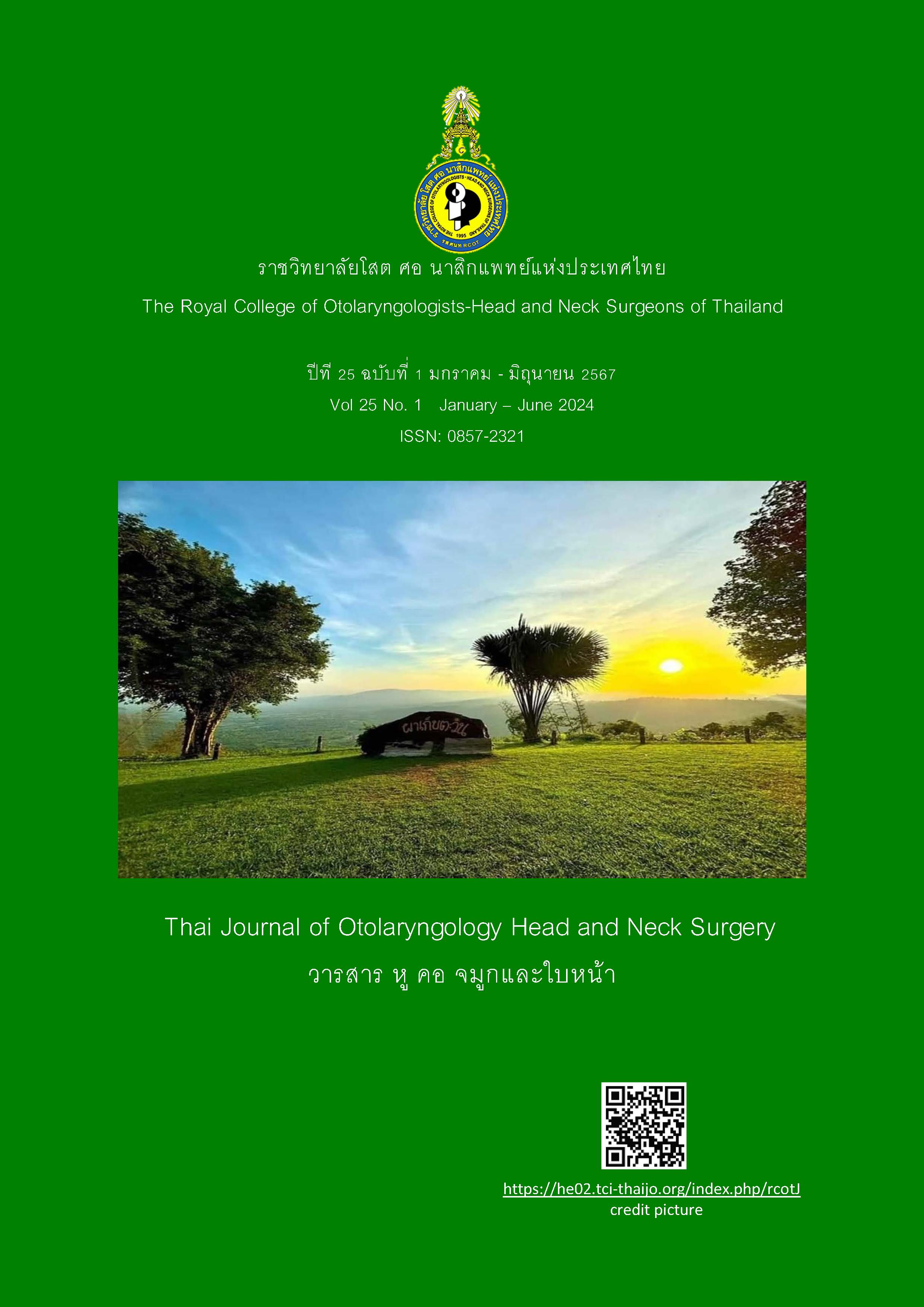Associated factors for tracheostomy dependence in advanced hypopharyngeal cancer with (chemo) radiation ปัจจัยที่สัมพันธ์กับการเจาะคอในมะเร็งช่องคอส่วนล่างระยะลุกลามที่รักษาด้วยรังสี รักษาหรือร่วมกับเคมีบ าบัด
Main Article Content
Abstract
Abstract
Objective: To study and compare factors associated with tracheostomy in locally advanced hypopharyngeal cancer patients treated with radiation therapy or concurrent chemoradiotherapy
Study design: This is a retrospective cohort analytic study conducted at Maharat Nakhon Ratchasima Hospital from January1, 2010, to December 31, 2022. A total of 131 patients with locally advanced hypopharyngeal cancer who underwent radiation therapy or concurrent chemoradiotherapy were included. The survival rate after tracheostomy was analyzed using Kaplan-Meier survival curves and Log-rank tests. Factors associated with the 1 -year tracheostomy-free rate were analyzed using Cox regression analysis, presenting Hazard ratios and 95% confidence intervals.
Results: Among the 131 patients, 34 (25.95%) required tracheostomy. The average patient follow-up is 91.1 individuals over one year. The tracheostomy rate is 3.1% during the 1-year follow-up period. The majority were male (93.1%), smokers (70.9%), and had tumors located in the pyriform sinus (77.8%). Factors significantly associated with tracheostomy included vocal cord immobility
(adjusted hazard ratio 46.69, 95% CI 6.27-347.47; p < 0.001), feeding tubes insertion during treatment (adjusted hazard ratio 4.44, 95% CI 1.83-10.77; p < 0.001), and palliative radiation therapy (adjusted hazard ratio 3.6, 95% CI 1.07-12.17; p = 0.039). The 1-year survival
tracheostomy-free rate was 64.3%, with an increasing trend in tracheostomy rate observed after 8 months.
Conclusion: In locally advanced hypopharyngeal cancer treated with radiation therapy or concurrent chemoradiotherapy, the 1-year tracheostomy-free rate was 64.3%, with an increasing trend in tracheostomy rates observed after 8 months. Factors significantly associated with tracheostomy included vocal cord immobility, feeding tube insertion during treatment, and palliative radiation
therapy, indicating statistically significant increase in tracheostomy risk.
Keywords: Malignant neoplasm of hypopharynx, tracheostomy dependence
Article Details

This work is licensed under a Creative Commons Attribution-NonCommercial-NoDerivatives 4.0 International License.
ต้นฉบับที่ส่งมาพิจารณายังวารสารหู คอ จมูก และใบหน้า จะต้องไม่อยู่ในการพิจารณาของวารสารอื่น ในขณะเดียวกันต้นฉบับที่จะส่งมาจะผ่านการอ่านโดยผู้ทรงคุณวุฒิ หากมีการวิจารณ์หรือแก้ไขจะส่งกลับไปให้ผู้เขียนตรวจสอบแก้ไขอีกครั้ง ต้นฉบับที่ผ่านการพิจารณาให้ลงตีพิมพ์ถือเป็นสมบัติของวารสารหู คอ จมูกและใบหน้า ไม่อาจนำไปลงตีพิมพ์ที่อื่นโดยไม่ได้รับอนุญาต
ตารางแผนภูมิ รูปภาพ หรือข้อความเกิน 100 คำที่คัดลอกมาจากบทความของผู้อื่น จะต้องมีใบยินยอมจากผู้เขียนหรือผู้ทรงลิขสิทธิ์นั้นๆ และใหร้ะบุกำกับไว้ในเนื้อเรื่องด้วย
References
เอกสารอ้างอิง
Hall SF, Groome PA, Irish J, et al. The natural history of patients with squamous cell carcinoma
of the hypopharynx. Laryngoscope 2008; 118: 1362-71.
Department of Veterans affairs laryngeal cancer study group. Induction chemotherapy plus
radiation compared with surgery plus radiation in patients with advanced laryngeal cancer. N Engl J Med 1991;324: 1685-90.
Forastiere AA, Zhang Q, Weber RS, et al. Long-term results of RTOG 91-11: a comparison of three
nonsurgical treatment strategies to preserve the lalrynx in patients with locally advanced larynx cancer. J Clin Oncol. 2013;31:845-52.
สมจินต์ จิดาวิจักษณ์, เสาวคนธ์ ศุกร โยธิน, สมชาย ธนะสิทธิชัย, และคณะ. แนวทางการตรวจวินิจฉัยและรักษา โรคมะเร็งกล่องเสียงและช่องคอ ส่วนล่าง. สถาบันมะเร็งแห่งชาติ กรมการแพทย์ กระทรวงสาธารณสุข. โฆษิตการพิมพ์ 2557: 1-76.
Rattana-anekchai T, Art-smart T, Vatanasapt P, et al. Conservation laryngectomy: experience in
Srinagarind hospital. Srinagarind Med J 2002; 17(3):164-70.
Bozec A, Poissonnet G, Dassonvillle D, et al. Current therapeutic strategies for patients with
hypopharyngeal carcinoma: oncologic and functional outcomes. J. Clin. Med. 2023; 12:1237-53.
Eckel HE, Bradley P. Treatment options for hypopharyngeal cancer. Adv Otorhinolaryngol. 2019: 83; 47-53.
Vourexakis Z, Janot F, Dulguerov P, et al. Larynx preservation protocols: long-term functional
outcomes in good responders to induction chemotherapy for pyriform sinus carcinoma. ORL 2014; 76: 165-70.
Tulunay-Ugur OE, McClinton C, Young Z, et al. Functional outcomes of chemoradiation in patients with head and neck cancer. Otolaryngol Head Neck Surg 2013; 148(1): 64-8.
Oken MM, Creech RH, Tormey DC, et al. Toxicity and response criteria of the Eastern Cooperative
Oncology Group. Am J Clin Oncol 1982; 5(6): 649-55.
Amin MB, Greene FL, Edge SB, et al. The eighth edition AJCC cancer staging manual: continuing
to build a bridge from a population-based to a more “personalized” approach to cancer staging. CA Cancer J Clin. 2017; 67(2):93-9.
Chen LY, Juang CC, Tsou Y, et al. Prognostic factor of severe complications in patients with
hypopharyngeal cancer with primary concurrent chemoradiotherapy. Anticancer research 2015; 35: 1735-42.
Anschuetz L, Shelan M, Dematte M, et al. Long-term function outcome after laryngeal cancer
treatment. Radiation Oncology 2019;14: 101-8.
Pruegsanusak K, Peeravut S, Leelamanit V, et al. Survival and prognostic factors of different
sites of head and neck cancer: an analysis from Thailand. Asian Pac J Cancer Prev. 2012;13:885- 90.
Tennant PA, Cash E, bumpous JM, et al. Persistent tracheostomy after primary chemoradiation for
advanced laryngeal or hypopharyngeal cancer. Head & Neck. 2014;36: 1628-33.
Batchelor CJJ, Flukes SP. Tracheostomy dependence following organ preservation (chemo)radiation
protocol for laryngeal and hypopharyngeal cancers. Head & Neck 2022; 44:2779-85.
Staton J, Robbins KT, Newman L, et al. Factors predictive of poor functional outcome after
chemoradiation for advanced laryngeal cancer. Otolaryngol head and neck surg 2002; 127(1):43-7.
Agarwal J, Palwe V Dutta D, et al. Objective assessment of swallowing function after definitive
concurrent (chemo)radiotherapy in patients with head and neck cancer. Dysphagia. 2011; 26: 399-406.
Jefferson GD, Wenig BL, Spiotto MT. Predictors and outcomes for chronic tracheostomy after
chemoradioaton for advanced laryngohypophayngeal cancer. Laryngoscope 2016;126: 385-91.
Mick R, Vokes EE, Weichselbaum RR, et al. Prognostic factors in advanced head and neck cancer
patients undergoing multimodality therapy. Otolaryngol Head Neck Surg. 1991; 105 62-73.
Langerman A, Patel RM, Cohen EE, et al. Airway management before chemoradiation for advanced
head and neck cancer. Head Neck. 2012; 34: 254-9.
Petersen JF, Timmermans AJ, Dijk BAC, et al. Trends in treatment, incidence and survival of
hypopharynx cancer: a 20-year population-based study in the Netherlands. Eur Arch Otorhinolaryngol.
;275: 181-9.
Anschuetz L, Visini M, Shelan M, et al. Risk analysis for tracheostomy dependency in
curatively treated laryngeal cancer with organ preservation. Head & Neck. 2018;40: 2469-75.


